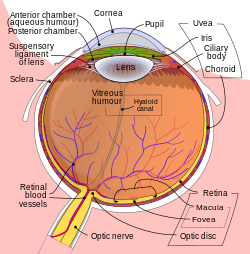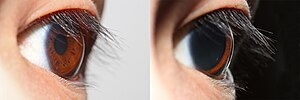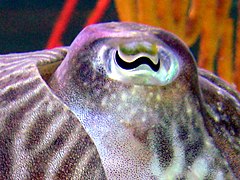Pupil
| Pupil | |
|---|---|
 The pupil is the central opening of the iris on the inside of the eye, which normally appears black. The grey/blue or brown area surrounding the pupil is the iris. The white outer area of the eye is the sclera. The central outermost transparent colorless part of the eye (through which we can see the iris and pupil) is the cornea. | |
 Cross-section of the human eye, showing the position of the pupil. | |
| Details | |
| Part of | Eye |
| System | Visual system |
| Identifiers | |
| Latin | pupilla. (plural: pupillae) |
| MeSH | D011680 |
| TA98 | A15.2.03.028 |
| TA2 | 6754 |
| FMA | 58252 |
| Anatomical terminology | |
The pupil is a hole located in the center of the
In humans, the pupil is circular, but its shape varies between species; some
Function
The iris is a contractile structure, consisting mainly of smooth muscle, surrounding the pupil. Light enters the eye through the pupil, and the iris regulates the amount of light by controlling the size of the pupil. This is known as the pupillary light reflex.
The iris contains two groups of smooth muscles; a circular group called the
The sensory pathway (rod or cone, bipolar, ganglion) is linked with its counterpart in the other eye by a partial crossover of each eye's fibers. This causes the effect in one eye to carry over to the other.
Effect of light

The pupil gets wider in the dark and narrower in light. When narrow, the diameter is 2 to 4 millimeters. In the dark it will be the same at first, but will approach the maximum distance for a wide pupil 3 to 8 mm. However, in any human age group there is considerable variation in maximal pupil size. For example, at the peak age of 15, the dark-adapted pupil can vary from 4 mm to 9 mm with different individuals. After 25 years of age, the average pupil size decreases, though not at a steady rate.[4][5] At this stage the pupils do not remain completely still, therefore may lead to oscillation, which may intensify and become known as hippus. The constriction of the pupil and near vision are closely tied. In bright light, the pupils constrict to prevent aberrations of light rays and thus attain their expected acuity; in the dark, this is not necessary, so it is chiefly concerned with admitting sufficient light into the eye.[6]
When bright light is shone on the eye, light-sensitive cells in the retina, including rod and cone photoreceptors and
Clinical significance
Effect of drugs
If the drug pilocarpine is administered, the pupils will constrict and accommodation is increased due to the parasympathetic action on the circular muscle fibers, conversely, atropine will cause paralysis of accommodation (cycloplegia) and dilation of the pupil.
Certain drugs cause constriction of the pupils, such as
The sphincter muscle has a parasympathetic innervation, and the dilator has a sympathetic innervation. In pupillary constriction induced by pilocarpine, not only is the sphincter nerve supply activated but that of the dilator is inhibited. The reverse is true, so control of pupil size is controlled by differences in contraction intensity of each muscle.
Another term for the constriction of the pupil is miosis. Substances that cause miosis are described as miotic. Dilation of the pupil is mydriasis. Dilation can be caused by mydriatic substances such as an eye drop solution containing tropicamide.
Diseases
A condition called bene dilitatism occurs when the optic nerves are partially damaged. This condition is typified by chronically widened pupils due to the decreased ability of the optic nerves to respond to light. In normal lighting, people affected by this condition normally have dilated pupils, and bright lighting can cause pain. At the other end of the spectrum, people with this condition have trouble seeing in darkness. It is necessary for these people to be especially careful when driving at night due to their inability to see objects in their full perspective. This condition is not otherwise dangerous.
Size
The size of the pupil (often measured as



Not all variations in size are indicative of disease however. In addition to dilation and contraction caused by light and darkness, it has been shown that solving simple multiplication problems affects the size of the pupil.[10] The simple act of recollection can dilate the size of the pupil,[11] however when the brain is required to process at a rate above its maximum capacity, the pupils contract.[12] There is also evidence that pupil size is related to the extent of positive or negative emotional arousal experienced by a person.[13]
Some humans are able to exert direct control over their iris muscles, giving them the ability to manipulate the size of their pupils (i.e. dilating and constricting them) on command, without any changes in lighting condition or eye accommodation state.[15] However, this ability is likely very rare and its purpose or advantages over those without it are unclear.
Animals
Not all animals have circular pupils. Some have slits or ovals which may be oriented vertically, as in crocodiles, vipers, cats and foxes, or horizontally as in some rays, flying frogs, mongooses and artiodactyls such as elk, red deer, reindeer and hippopotamus, as well as the domestic horse. Goats, sheep, toads and octopus pupils tend to be horizontal and rectangular with rounded corners. Some skates and rays have crescent shaped pupils,[16] gecko pupils range from circular, to a slit, to a series of pinholes,[17] and the cuttlefish pupil is a smoothly curving W shape. Although human pupils are normally circular, abnormalities like colobomas can result in unusual pupil shapes, such as teardrop, keyhole or oval pupil shapes.
There may be differences in pupil shape even between closely related animals. In felids, there are differences between small- and large eyed species. The domestic
Evolution and adaptation
One explanation for the
Activity pattern and behavior
In a study of
A 2015 study[22] confirmed the hypothesis that elongated pupils have increased dynamic range, and furthered the correlations with diel activity. However it noted that other hypotheses could not explain the orientation of the pupils. They showed that vertical pupils enable ambush predators to optimise their depth perception, and horizontal pupils to optimise the field of view and image quality of horizontal contours. They further explained why elongated pupils are correlated with the animal's height.
- Animals with non-circular pupils
-
A goat with horizontal rectangular pupils
-
A stingray with crescent pupils
-
A crocodile with thin vertical slit pupils
-
A cuttlefish with W-shaped pupils
-
A gecko with 'thin string of pearls' pupils
-
A cat with thick vertical slit pupils
Society and culture
The pupil plays a role in eye contact and nonverbal communication. The voluntary or involuntary enlargement or dilation of the pupils indicates cognitive arousal, interest in the subject of attention, and/or sexual arousal. On the other hand, when the pupil is voluntarily or involuntarily contracted, it could indicate the opposite - disinterest or disgust. Exceptionally large or dilated pupils are also perceived to be an attractive feature in body language.[23]
In a surprising number of unrelated languages, the etymological meaning of the term for pupil is "little person".[24][25] This is true, for example, of the word pupil itself: this comes into English from Latin pūpilla, which means "doll, girl", and is a diminutive form of pupa, "girl". (The double meaning in Latin is preserved in English, where pupil means both "schoolchild" and "dark central portion of the eye within the iris".)[26] This may be because the reflection of one's image in the pupil is a minuscule version of one's self.[24] In the Old Babylonian period (c. 1800-1600 BC) in ancient Mesopotamia, the expression "protective spirit of the eye" is attested, perhaps arising from the same phenomenon.
The English phrase apple of my eye arises from an Old English usage, in which the word apple meant not only the fruit but also the pupil or eyeball.[27]
See also
- Pupillary response
- Pupil function
- Dilated fundus examination
- Eye contact
- Horner's syndrome
- Mydriasis
- Synechia (eye)
- Anisocoria
- Adie's pupil
- Argyll Robertson pupil
- Light-near dissociation
- Marcus Gunn Pupil
References
- ^ Cassin, B. and Solomon, S. (1990) Dictionary of Eye Terminology. Gainesville, Florida: Triad Publishing Company.
- PMID 25667112.
- ^ PMID 16354774.
- ^ "Aging Eyes and Pupil Size". Amateurastronomy.org. Archived from the original on 2013-10-23. Retrieved 2013-08-28.
- PMID 8125724. Retrieved 2013-08-28.
- ^ "Sensory Reception: Human Vision: Structure and Function of the Eye" Encyclopædia Brtiannicam Chicago, 1987
- S2CID 9591926.
- PMID 10533519. Retrieved March 22, 2018.
- S2CID 73382801.
- S2CID 27169110.
- ISBN 978-0805849516.
- ^ "My Brain is Overloaded". prezi.com. Retrieved 2017-02-28.
- S2CID 7007209.
- S2CID 27407880.
- ISSN 0167-8760.
- .
- PMID 19757966.
- OCLC 10363617.
- ISBN 978-3-642-66468-7.
- PMID 16527734.
- ^ PMID 20629855.)
{{cite journal}}: CS1 maint: multiple names: authors list (link - PMID 26601232.
- ISSN 1090-5138.
- ^ S2CID 8522764.
- JSTOR 644304.
- ^ "pupil, n.2.", Oxford English Dictionary Online, 3rd. edn (Oxford University Press, 2007).
- ^ apple, n.", Oxford English Dictionary Online, 3rd ed. (Oxford University Press, 2008), § 6 B.
External links
- Atlas image: eye_1 at the University of Michigan Health System — "Sagittal Section Through the Eyeball"
- Atlas image: eye_2 at the University of Michigan Health System — "Sagittal Section Through the Eyeball"
- A pupil examination simulator, demonstrating the changes in pupil reactions for various nerve lesions.







